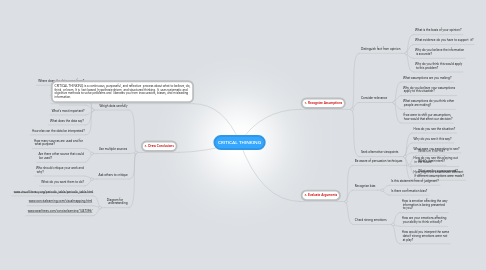
1. 3. Draw Conclusions
1.1. Weigh data carefully
1.1.1. Where does the data come from?
1.1.2. Why consider the data?
1.1.3. Is data relevant?
1.1.4. What's most important?
1.1.5. What does the data say?
1.1.6. How else can the data be interpreted?
1.2. Use multiple sources
1.2.1. How many sources are used and for what purpose?
1.2.2. Are there other source that could be used?
1.3. Ask others to critique
1.3.1. Who should critique your work and why?
1.3.2. What do you want them to do?
1.4. Diagram for understanding
1.4.1. www.visual-literacy.org/periodic_table/periodic_table.html
1.4.2. www.conciselearning.com/visualmapping.html
1.4.3. www.pearltrees.com/conciselearning/1447396/
2. CRITICAL THINKING is a continuous, purposeful, and reflective process about what to believe, do, think, or learn. It is fact based, hypothesis-driven, and structured thinking. It uses systematic and objective methods to solve problems and liberates you from inaccuracies, biases, and misleading information.
3. 1. Recognize Assumptions
3.1. Distinguish fact from opinion
3.1.1. What is the basis of your opinion?
3.1.2. What evidence do you have to support it?
3.1.3. Why do you believe the information is accurate?
3.1.4. Why do you think this would apply to this problem?
3.2. Consider relevance
3.2.1. What assumptions are you making?
3.2.2. Why do you believe your assumptions apply to this situation?
3.2.3. What assumptions do you think other people are making?
3.2.4. If we were to shift our assumptions, how would that affect our decision?
3.3. Seek alternative viewpoints
3.3.1. How do you see the situation?
3.3.2. Why do you see it this way?
3.3.3. What were you expecting to see?
3.3.4. How do you see this playing out in the future?
3.3.5. How might the situation be different if different assumptions were made?
4. 2. Evaluate Arguments
4.1. Be aware of persuasion techniques
4.1.1. What's in it for me?
4.1.2. What's their intent?
4.1.3. What are the consequences?
4.2. Recognize bias
4.2.1. Is this statement free of judgment?
4.2.2. Is there confirmation bias?
4.3. Check strong emotions
4.3.1. How is emotion affecting the way information is being presented to you?
4.3.2. How are your emotions affecting your ability to think critically?
4.3.3. How would you interpret the same data if strong emotions were not at play?
